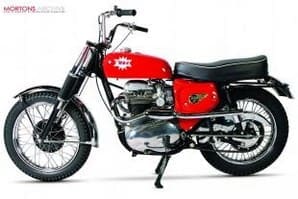
Derek Gothard is a regular face on the classic concours scene, with his stream of brilliant and quite beautiful unit BSA twins regularly picking up prizes and wowing judges and the public alike with their factory-fresh finish and obvious painstaking preparation. And this Spitfire Hornet is no exception. Meanwhile, Derek’s work has started to be noticed in other places too – his similarly excellent Lightning, which was featured on the cover of our May 2002 edition, is now owned by Scottish film star Ewan McGregor.
This particularly rare unit twin was acquired by Derek, a 54-year-old carpenter and joiner from Rayleigh in Essex, in 2004. The 1965 machine took him six months to restore, while he singles out Burton Bike Bits for praise with their supply of spare parts.
Enjoy more Classic MotorCycle reading in the monthly magazine.
Click here to subscribe & save.
The rarity of the Spitfire Hornet was the main attraction for Derek, who actively searches out the more obscure and unusual models in the unit BSA range. And they don’t come too much scarcer than this model.
The Spitfire Hornet was a US-only model, built just for the 1965 season and specially tailored to the desert racing market. To that end, it was fitted with high and wide handlebars, two-gallon glass fibre petrol tank, knobbly tyres and no instruments. Ignition was by a Lucas energy transfer system, which powered the coils directly from the alternator, negating the need for a battery to be fitted. It was fast too. Said Cycle World in 1965: “Faster in the quarter than any other scrambler we have ever tested, and within mere fractions of being the fastest-accelerating motorcycle we have ever tested – period.”
500cc Cyclone
Based upon the 500cc Cyclone, the modifications were the fitting of the 650cc engine plus a two-inch longer swinging arm to aid stability. The Spitfire Hornet was replaced for 1966 by the more simply monikered Hornet, which was basically the same as the model it replaced and remained just as focussed; all that really changed was the name plus a few details.
The Hornet lost some of that focus for the 1967 season, with the 11⁄8in Monobloc carburettors swapped for Concentrics, though it was still sold as purely an off-road racer, not suitable for highway use.
For 1968, The Hornet was replaced by the Firebird Scrambler, though this was no direct replacement, being fitted with full road going equipment and a less highly tuned engine. It seemed that the large capacity desert scrambler was now gone for ever – as two-strokes took over in that competition sphere. However, these big and beefy off-road twins have always held a fascination for enthusiasts as Derek’s latest restoration proves. ![]()
Advert
 Enjoy more The Classic MotorCycle reading in the monthly magazine. Click here to subscribe.
Enjoy more The Classic MotorCycle reading in the monthly magazine. Click here to subscribe.



